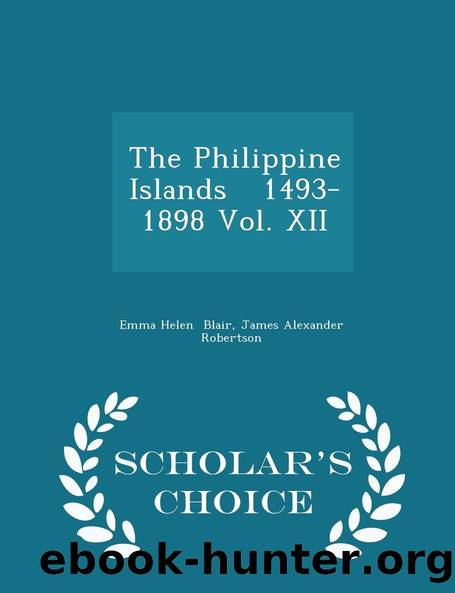The Philippine Islands, 1493-1898 â Volume 18 of 55 by Unknown

Author:Unknown
Language: eng
Format: epub
ISBN: 9781318815234
Google: qh_HDAEACAAJ
Goodreads: 11301365
Publisher: HardPress
Published: 2016-06-23T18:32:19+00:00
* * *
1 From internal evidence it is apparent that this relation is written from Nueva España, a thing which the reader must constantly keep in mind; also that it was written in 1619âprobably in January or February, as it was considered by the Council in May of that year.
2 Delgado (Historia, pp. 418, 419) and Blanco (Flora, pp. 428â429) describe a tree called dangcalan, or palo marÃa (calophyllum inophyllumâLinn.), which is probably the tree referred to in the text. While generally a tree of ordinary size, it is said to grow to huge dimensions in Mindanao. Besides its use as above mentioned, an oil or balsam is distilled from the leaves, or obtained from the trunk, which has valuable medicinal uses, in both external and internal application. This oil sometimes serves to give light, but the light is dim, and to anoint the hoofs of horses. It blooms in November, the flowers growing in bunches of seven or nine each; and its leaf is oval and tapering. The wood is light, exceedingly tough, and reddish in color. It is very plentiful in the Visayas, and generally grows close to the water. It is known by a number of different names, among them being bitanhol or bitanjol, and dincalin.
3 Perhaps the guijo (also spelt guiso or guisoc; Dipterocarpus guisoâBl.), a wood of red color, which is strong, durable, tough, and elastic; it produces logs 75 feet long by 24 inches square, and is now used in Hongkong for wharf-decks and flooring, but in Manila for carriage shafts (U.S. Gazetteer of Philippine Islands). Blanco says that this tree is much esteemed for carriage-wheels, and is also used for topmasts and keels. The Indians call it guiso, but the Spaniards have corruptly called it guijo. It is common in Mindoro.
4 Probably the lauan (also called lauaan and sándana; Dipterocarpus thuriferaâLinn.), a reddish white or ashy wood with brown spots, used chiefly in the construction of canoes, and producing logs 75 feet long by 24 inches square (U.S. Gazetteer). Blanco says that this tree yields a fragrant, hard, white resin, which is used instead of incense in the churches. San Agustin, quoted by Blanco, says that the planks of the sides of the ancient galleys were of lauaan, for balls do not chip this wood. Delgado mentions two species: lauaan mulato, in color almost dark red; and lauaan blanco (white), which was used as planking for boats.
5 That is, the cubit; a measure of length equal to the distance from the elbow to the end of the middle finger. The codo real, or royal cubit, is three fingers longer than the ordinary codo. The geometrical codo is equivalent to 418 mm., and the codo real to 574 mm. See Velásquez: New Dictionary of Spanish language (New York, 1902).
6 The banabá (LagerstrÅmia speciosaâPers.; Munchausia speciosa; LagerstrÅmia flos reginæâRetz.) grows to a height of thirty to fifty feet, and varies in color from reddish white to dull red. Its flowers are red and very beautiful, and bloom in March.
Download
This site does not store any files on its server. We only index and link to content provided by other sites. Please contact the content providers to delete copyright contents if any and email us, we'll remove relevant links or contents immediately.
| Africa | Americas |
| Arctic & Antarctica | Asia |
| Australia & Oceania | Europe |
| Middle East | Russia |
| United States | World |
| Ancient Civilizations | Military |
| Historical Study & Educational Resources |
Cat's cradle by Kurt Vonnegut(14784)
Pimp by Iceberg Slim(13807)
Underground: A Human History of the Worlds Beneath Our Feet by Will Hunt(11848)
4 3 2 1: A Novel by Paul Auster(11820)
The Radium Girls by Kate Moore(11639)
Wiseguy by Nicholas Pileggi(5333)
American History Stories, Volume III (Yesterday's Classics) by Pratt Mara L(5141)
Perfect Rhythm by Jae(5080)
The Fire Next Time by James Baldwin(5033)
Paper Towns by Green John(4811)
Pale Blue Dot by Carl Sagan(4632)
A Higher Loyalty: Truth, Lies, and Leadership by James Comey(4566)
The Mayflower and the Pilgrims' New World by Nathaniel Philbrick(4287)
The Doomsday Machine by Daniel Ellsberg(4253)
Killers of the Flower Moon: The Osage Murders and the Birth of the FBI by David Grann(4197)
Too Much and Not the Mood by Durga Chew-Bose(4105)
The Sympathizer by Viet Thanh Nguyen(4099)
The Borden Murders by Sarah Miller(4032)
Sticky Fingers by Joe Hagan(3916)
